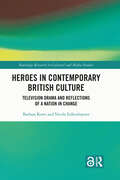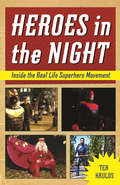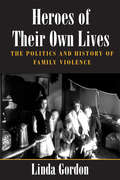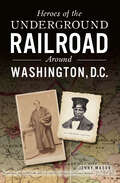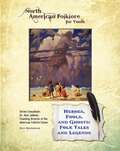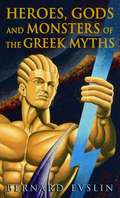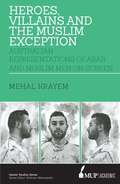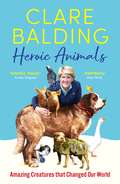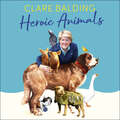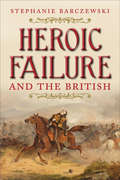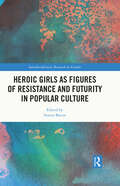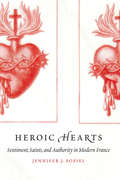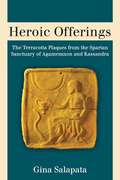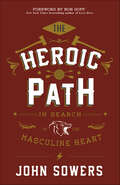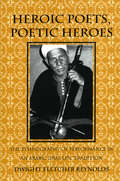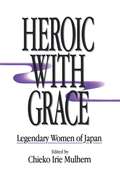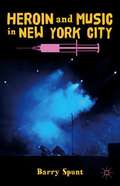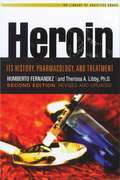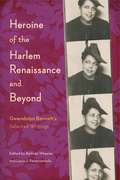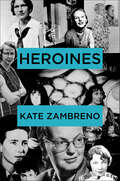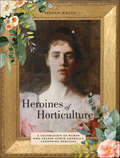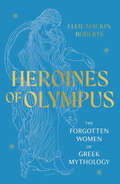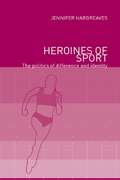- Table View
- List View
Heroes in Contemporary British Culture: Television Drama and Reflections of a Nation in Change (Routledge Research in Cultural and Media Studies)
by Nicole Falkenhayner Barbara KorteThis book explores how British culture is negotiating heroes and heroisms in the twenty-first century. It posits a nexus between the heroic and the state of the nation and explores this idea through British television drama. Drawing on case studies including programmes such as The Last Kingdom, Spooks, Luther and Merlin, the book explores the aesthetic strategies of heroisation in television drama and contextualises the programmes within British public discourses at the time of their production, original broadcasting and first reception. British television drama is a cultural forum in which contemporary Britain’s problems, wishes and cultural values are revealed and debated. By revealing the tensions in contemporary notions of heroes and heroisms, television drama employs the heroic as a lens through which to scrutinise contemporary British society and its responses to crisis and change. Looking back on the development of heroic representations in British television drama over the last twenty years, this book’s analyses show how heroisation in television drama reacts to, and reveals shifts in, British structures of feeling in a time marked by insecurity. The book is ideal for readers interested in British cultural studies, studies of the heroic and popular culture.
Heroes in Contemporary British Culture: Television Drama and Reflections of a Nation in Change (Routledge Research in Cultural and Media Studies)
by Nicole Falkenhayner Barbara KorteThis book explores how British culture is negotiating heroes and heroisms in the twenty-first century. It posits a nexus between the heroic and the state of the nation and explores this idea through British television drama.Drawing on case studies including programmes such as The Last Kingdom, Spooks, Luther and Merlin, the book explores the aesthetic strategies of heroisation in television drama and contextualises the programmes within British public discourses at the time of their production, original broadcasting and first reception. British television drama is a cultural forum in which contemporary Britain’s problems, wishes and cultural values are revealed and debated. By revealing the tensions in contemporary notions of heroes and heroisms, television drama employs the heroic as a lens through which to scrutinise contemporary British society and its responses to crisis and change. Looking back on the development of heroic representations in British television drama over the last twenty years, this book’s analyses show how heroisation in television drama reacts to, and reveals shifts in, British structures of feeling in a time marked by insecurity.The book is ideal for readers interested in British cultural studies, studies of the heroic and popular culture.Introduction of this book is freely available as a downloadable Open Access PDF at http://www.taylorfrancis.com under a Creative Commons [Attribution (CC-BY-)] 4.0 license.
Heroes in the Night: Inside the Real Life Superhero Movement
by Tea KrulosTracing the author's journey into the strange subculture of Real Life Superheroes (RLSHs), this book examines citizens who have adopted comic book-style personas and have hit the streets to fight injustice in a variety of ways. Some RLSHs concentrate on humanitarian or activist missions--helping the homeless, gathering donations for food banks, or delivering toys to children--while others actively patrol their neighborhoods looking for crime to fight. By day, these modern Clark Kents work as dishwashers, pencil pushers, and executives in Fortune 500 companies, but by night they become heroes for the people. Through historic research and extensive interviews, this work shares not only their shining, triumphant moments, but also some of their ill-advised, terrifying disasters.
Heroes of Their Own Lives: The Politics and History of Family Violence--Boston, 1880-1960
by Linda GordonIn this unflinching history of family violence, the historian Linda Gordon traces policies on child abuse and neglect, wife beating, and incest from 1880 to 1960. Gordon begins with the so-called discovery of family violence in the 1870s, when experts first identified it as a social rather than personal problem. From there, Gordon chronicles the changing visibility of family violence as gender, family, and political ideologies shifted and the women’s and civil rights movements gained strength. Throughout, she illustrates how public perceptions of issues like marriage, poverty, alcoholism, mental illness, and responsibility worked for and against the victims of family violence, and looks at the link between family violence and larger social problems. Powerful and moving, Heroes of Their Own Lives offers an honest understanding of a persistent problem and a realistic view of the difficulties in stopping it.
Heroes of the Underground Railroad Around Washington, D. C. (American Heritage Ser.)
by Jenny MasurMany of the unsung heroes of the Underground Railroad lived and worked in Washington, D.C.Men and women, black and white, operatives and freedom seekers - all demonstrated courage, resourcefulness and initiative. Leonard Grimes, a free African American, was arrested for transporting enslaved people to freedom. John Dean, a white lawyer, used the District courts to test the legality of the Fugitive Slave Act. Anna Maria Weems dressed as a boy in order to escape to Canada. Enslaved people engineered escapes, individually and in groups, with and without the assistance of an organized network. Some ended up back in slavery or in jail, but some escaped to freedom. Anthropologist and author Jenny Masur tells their stories.
Heroes, Fools, and Ghosts: Folk Tales and Legends (North American Folklore for Youth)
by Gus SnedekerHave you heard of Anansi, the mischief-making spider from Africa? Do you know about the Blackfoot woman who married a star? Or have you heard stories about Jack, the hero who always wins both the treasure and the princess's heart? Discover stories from North America's folklore, including tales about: * why the world is the way it is * heroes and fools * ghosts and horrors * death and the world to come. Stories have power. They share the wisdom of other generations. They stir our imagination. They give us hope and courage. And sometimes they just make us laugh!
Heroes, Gods and Monsters of the Greek Myths
by Bernard EvslinThe earth breeds giants and ogres of indescribable horror -- the heavens hold omnipotent gods and goddesses, abounding in courage, strength and wisdom. Zeus, the almighty king of the gods, who cannot resist feminine beauty -- mortal or divine, and his jealous and vengeful wife, Hera. Perseus, fearless mortal warrior, who takes on an impossible challenge: slaying the monstrous Medusa, whose glance turns men to stone. The Minotaur, half-man and half-bull, the horrible fruit of a queen's unspeakable desire, who annually destroys the young victims sacrificed to his terrifying power.
Heroes, villains and the muslim exception: Muslim and Arab Men in Australian Crime Drama (Islamic Studies Series)
by Mehal KrayemHeroes, Villains and the Muslim Exception explores recent crime drama film and television depictions of Arab and Muslim men in Australia. It examines the representation of three Australian productions: East West 101, The Combination and Cedar Boys. Since 2007 Australia has seen a notable increase in the inclusion of Arab and Muslim male characters in various serials and films, but what do these inclusions mean for the place of Arab and Muslim men in Australia today? This book seeks to understand how these representations are constructed and whether they are as progressive and edgy as producers and media responses would suggest. This book explores the extent to which cultural productions such as East West 101, The Combination and Cedar Boys open up a space for new understandings of the place of Arab and Muslim Australians in contemporary Australia. Importantly it considers the role of the Special Broadcasting Service in the plight of anti-racism. Islamic Studies Series - Volume 23
Heroic Animals: 100 Amazing Creatures Great and Small
by Clare BaldingBobbie the Wonder dog crossed more than 2,500 miles of plains, desert and mountains to find his way home - and became the inspiration for Lassie. Cher Ami the pigeon, despite being shot twice, delivered a message that saved the lives of 194 soldiers in 1918.Trakr the police dog spent two days exhaustively searching Ground Zero and found the last survivor of the 9/11 attacks.Ever since Alexander the Great named a city after the horse who saved his life in battle (and another after his dog), human history wouldn't be the same without the awe-inspiring tales of amazing animals.Now BAFTA-winning presenter, no. 1 bestselling author and all-round national treasure Clare Balding picks out the most heroic and heartwarming (and sometimes hilarious) animals from history and tells their stories. From Simon the sea cat to Greyfriars Bobby's 14-year vigil over his master's grave, to the elephant that saved a small girl and Paul the World-Cup-predicting octopus, Heroic Animals brings to life incredible feats and moving moments which highlight the timeless special bond between human and animal.
Heroic Animals: 100 Amazing Creatures Great and Small
by Clare BaldingBobbie the Wonder dog crossed more than 2,500 miles of plains, desert and mountains to find his way home - and became the inspiration for Lassie. Cher Amithe pigeon, despite being shot twice, delivered a message thatsaved the lives of 194 soldiers in 1918.Trakr the police dog spent two days exhaustively searching Ground Zero and found the last survivor of the 9/11 attacks.Ever since Alexander the Great named a city after the horse who saved his life in battle (and another after his dog), human history wouldn't be the same without the awe-inspiring tales of amazing animals.Now BAFTA-winning presenter, no. 1 bestselling author and all-round national treasure Clare Balding picks out the most heroic and heartwarming (and sometimes hilarious) animals from history and tells their stories. From Simon the sea cat to Greyfriars Bobby's 14-year vigil over his master's grave, to the elephant that saved a small girl and Paul the World-Cup-predicting octopus, Heroic Animals brings to life incredible feats and moving moments which highlight the timeless special bond between human and animal.
Heroic Animals: 100 Amazing Creatures Great and Small
by Clare Balding100 of the most heroic, inspirational (and sometimes hilarious) animals from history, brought to life by national treasure, Clare Balding.Bobbie the Wonder dog crossed more than 2,500 miles of plains, desert and mountains to find his way home - and became the inspiration for Lassie. Cher Ami the pigeon, despite being shot twice, delivered a message that saved the lives of 194 soldiers in 1918.Trakr the police dog spent two days exhaustively searching Ground Zero and found the last survivor of the 9/11 attacks.Ever since Alexander the Great named a city after the horse who saved his life in battle (and another after his dog), human history wouldn't be the same without the awe-inspiring tales of amazing animals.Now BAFTA-winning presenter, no. 1 bestselling author and all-round national treasure Clare Balding picks out the most heroic and heartwarming (and sometimes hilarious) animals from history and tells their stories. From Simon the sea cat to Greyfriars Bobby's 14-year vigil over his master's grave, to the elephant that saved a small girl and Paul the World-Cup-predicting octopus, Heroic Animals brings to life incredible feats and moving moments which highlight the timeless special bond between human and animal.(P)2020 Hodder & Stoughton Limited
Heroic Failure and the British
by Stephanie BarczewskiFrom the Charge of the Light Brigade to Scott of the Antarctic and beyond, it seems as if glorious disaster and valiant defeat have been essential aspects of the British national character for the past two centuries. In this fascinating book, historian Stephanie Barczewski argues that Britain's embrace of heroic failure initially helped to gloss over the moral ambiguities of imperial expansion. Later, it became a strategy for coming to terms with diminishment and loss. Filled with compelling, moving, and often humorous stories from history, Barczewski's survey offers a fresh way of thinking about the continuing legacy of empire in British culture today.
Heroic Girls as Figures of Resistance and Futurity in Popular Culture (ISSN)
by Simon BaconHeroic Girls looks at the recent proliferation of young girl heroes in many recent mainstream films and books. These contemporary ‘final’ girls do not just survive but rather suggest that in doing so they have fundamentally changed something about themselves and or the world around them, seeing them become the ‘First Girls’ of this altered reality. The collection brings together a wide range of perspectives and cultural viewpoints that describe many recent narratives that explore the idea of a Final Girl and her “after-story”. The essays are divided into four sections, beginning with more theoretical approaches; cross-cultural examples; the ways in which fictional narratives bear strong relation to real-world circumstances; examples that more strongly depict themes of resistance, survival, and individual agency; and, finally, those that describe something more fundamental and transformative. Films and television shows covered in the collection include The Girl with All the Gifts, The Witcher, The Hunger Games, Star Wars, The Fear Street and Pan’s Labyrinth. This book will be of interest to researchers and students of film studies, gender studies, and media studies.
Heroic Hearts: Sentiment, Saints, and Authority in Modern France
by Jennifer J. PopielHeroic Hearts examines how young women in nineteenth-century France, authorized by a widespread cultural discourse that privileged individual authority over domesticity and marriage, sought to change the world. Jennifer J. Popiel offers a recuperative reading of sentimental authority, especially in its relationship to religious vocabulary. Heroic Hearts uncovers the ways sentimental appeals authorized women to trust themselves as modern actors for a project of cultural restoration. With their emphasis on sacrifice and heroism, these cultural currents offered liberatory potential.Heroic Hearts examines not only general cultural currents but their adoption by particular women, each of whom was privileged with access to money and social influence. The words of three extraordinary women, Philippine Duchesne, Pauline Jaricot, and Zélie Martin, offer powerful testimony to their agency. These women&’s rejection of &“traditional&” domesticity, believed to be a formative influence for their class, demonstrates how women understood the imperative to change the world outside of their natural families. Their writings, which demonstrate the appeal of sentimental virtue, show us how women&’s public lives could exist not in opposition to prevailing religious and social ideals but because of them.
Heroic Offerings: The Terracotta Plaques From The Spartan Sanctuary Of Agamemnon And Kassandra
by Gina SalapataHeroic Offerings sheds light on the study of religion in Sparta, one of Greece's most powerful city-states and the long-term rival of Athens. Sparta's history is well known, but its archaeology has been much less satisfactorily explored. Through the comprehensive study of a distinctive class of terracotta votive offerings from a specific sanctuary, Gina Salapata explores both coroplastic art and regional religion. By integrating archaeological, historical, literary, and epigraphic sources, she provides important insights into the heroic cults of Lakonia and contributes to an understanding of the political and social functions of local ritual practice. This volume focuses on a large group of decorated terracotta plaques, from the sixth to fourth centuries BCE. These molded plaques were discovered with other offerings in a sanctuary deposit excavated near Sparta more than fifty years ago, but they have remained unpublished until now. They number over 1,500 complete and fragmentary pieces. In technique, style, and iconography they form a homogeneous group unlike any other from mainland Greece. The large number of plaques and variety of types reveal a stable and vigorous coroplastic tradition in Lakonia during the late Archaic and Classical period. Heroic Offerings will be of interest to students and scholars of Greek history, art, and archaeology, to those interested in ancient religious practice in the Mediterranean, and to all inspired by Athens' chief political rival, Sparta. This volume received financial support from the Archaeological Institute of America.
Heroic Path: In Search of the Masculine Heart
by John SowersGod designed men to live with risk, adventure, and danger. But today's man has no rites of passage, no elders, no map to manhood. He may physically be an adult, but still wonders, "Am I a man?" When John Sowers twin daughters were born, he felt exposed, thinking manhood was out of reach. He needed direction. Following in the steps of ordinary men and the heroes of history, legend and myth, he uncovered a new and ancient road.Walk with John on his personal quest to discover the "wild masculine" and to become all that God intended men to be. From a thrilling brush with Kodiak bears in Alaska, to a war hero who rescued his comrades in the Valley of Death, from mythic heroes of Tolkien, to the footsteps of the One, True Myth - as Jesus walked from village into the wilderness, and back again. Stunningly written, this revolutionary book calls older men out of complacency and younger men out of confusion. It calls all men into the greater Story - into a life of sacrificial love, holy defiance, and clear purpose.
Heroic Poets, Poetic Heroes: The Ethnography of Performance in an Arabic Oral Epic Tradition (Myth and Poetics)
by Dwight F. ReynoldsAn astonishingly rich oral epic that chronicles the early history of a Bedouin tribe, the Sirat Bani Hilal has been performed for almost a thousand years. In this ethnography of a contemporary community of professional poet-singers, Dwight F. Reynolds reveals how the epic tradition continues to provide a context for social interaction and commentary. Reynolds’s account is based on performances in the northern Egyptian village in which he studied as an apprentice to a master epic-singer. Reynolds explains in detail the narrative structure of the Sirat Bani Hilal as well as the tradition of epic singing. He sees both living epic poets and fictional epic heroes as figures engaged in an ongoing dialogue with audiences concerning such vital issues as ethnicity, religious orientation, codes of behavior, gender roles, and social hierarchies.
Heroic with Grace: Legendary Women of Japan
by Chieko Irie MulhernThis work presents the lives and times of eight prominent Japanese women who epitomize the tragedies and triumphs of eight characteristically female roles. In examining the lives of the mythological Empress Jingu, Jito Tenno (645-702), Murasaki Shikibu (970s-1000s), Tomoe Gozen (12th century), Hojo Masako (1157-1225), Hani Motoko (1873-1957), Takamine Hideko (b.1924) and Ariyoshi Sawako (1931-1984), the contributors provide a mosaic of Japanese history and culture that encompasses issues of women's status in various stages of Japanese history, the social climate conducive to positive female roles, the concept of Japanese womanhood in relation to the male hero types of each age and the popular need for strong female figures.
Heroin and Music in New York City
by Barry SpuntUsing narrative accounts from a sample of 69 New York City-based musicians of various genres who are self-acknowledged heroin users, the book addresses the reasons why these musicians started using heroin and the impact heroin had on these musicians' playing, creativity, and careers.
Heroin: Its History, Pharmacology & Treatment
by Therissa A. Libby Humberto FernandezAn up-to-the-minute, comprehensive examination of heroin's history, pharmacology, psychology, and sociology, Heroin offers a spellbinding account of the drug's power and persistent allure, its medicinal benefits, and its destructive nature.This updated and expanded second edition provides new research into heroin's effects on the brain, the changing attitudes and policies about methadone and medications, and the different approaches to treating heroin addicts. Included are studies of violence along the U.S.-Mexican border--which has put heroin trafficking in the spotlight--as well as a focus on how the wars in Iraq and Afghanistan have made opium a valuable commodity and a major source of funds for terrorists. Animated with vivid personal stories and vignettes, Heroin puts a human face on the long and complex story behind this notorious drug.
Heroine of the Harlem Renaissance and Beyond: Gwendolyn Bennett’s Selected Writings (G - Reference, Information and Interdisciplinary Subjects)
by Louis J. Parascandola Belinda WheelerPoet, columnist, artist, and fiction writer Gwendolyn Bennett is considered by many to have been one of the youngest leaders of the Harlem Renaissance and a strong advocate for racial pride and the rights of African American women. Heroine of the Harlem Renaissance and Beyond presents key selections of her published and unpublished writings and artwork in one volume.From poems, short stories, and reviews to letters, journal entries, and art, this collection showcases Bennett’s diverse and insightful body of work and rightfully places her alongside her contemporaries in the Harlem Renaissance—figures such as Zora Neale Hurston, Langston Hughes, and Countee Cullen. It includes selections from her monthly column “The Ebony Flute,” published in Opportunity, the magazine of the National Urban League, as well as newly uncovered post-1928 work that proves definitively that Bennett continued writing throughout the following two decades. Bennett’s correspondence with canonical figures from the period, her influence on Harlem arts institutions, and her political writings, reviews, and articles show her deep connection to and lasting influence on the movement that shaped her early career.An indispensable introduction to one of the era’s most prolific and passionate minds, this reevaluation of Bennett’s life and work deepens our understanding of the Harlem Renaissance and enriches the world of American letters. It will be of special value to scholars and readers interested in African American literature and art and American history and cultural studies.
Heroines
by Kate ZambrenoA manifesto for "toxic girls" that reclaims the wives and mistresses of modernism for literature and feminism.I am beginning to realize that taking the self out of our essays is a form of repression. Taking the self out feels like obeying a gag order―pretending an objectivity where there is nothing objective about the experience of confronting and engaging with and swooning over literature."― from HeroinesOn the last day of December, 2009 Kate Zambreno began a blog called Frances Farmer Is My Sister, arising from her obsession with the female modernists and her recent transplantation to Akron, Ohio, where her husband held a university job. Widely reposted, Zambreno's blog became an outlet for her highly informed and passionate rants about the fates of the modernist "wives and mistresses." In her blog entries, Zambreno reclaimed the traditionally pathologized biographies of Vivienne Eliot, Jane Bowles, Jean Rhys, and Zelda Fitzgerald: writers and artists themselves who served as male writers' muses only to end their lives silenced, erased, and institutionalized. Over the course of two years, Frances Farmer Is My Sister helped create a community where today's "toxic girls" could devise a new feminist discourse, writing in the margins and developing an alternative canon.In Heroines, Zambreno extends the polemic begun on her blog into a dazzling, original work of literary scholarship. Combing theories that have dictated what literature should be and who is allowed to write it―from T. S. Eliot's New Criticism to the writings of such mid-century intellectuals as Elizabeth Hardwick and Mary McCarthy to the occasional "girl-on-girl crime" of the Second Wave of feminism―she traces the genesis of a cultural template that consistently exiles female experience to the realm of the "minor," and diagnoses women for transgressing social bounds. "ANXIETY: When she experiences it, it's pathological," writes Zambreno. "When he does, it's existential." By advancing the Girl-As-Philosopher, Zambreno reinvents feminism for her generation while providing a model for a newly subjectivized criticism.
Heroines of Horticulture: A Celebration of Women Who Shaped North America's Gardening Heritage
by Stefan WhiteA celebration and a salute to 100 brave, determined, creative women over the past few centuries who have shaped North America’s heritage and landscapes through their horticulture work and contributions. Through tales of invention, creativity, dogged research, innovation, perspiration, and inspiration spanning from the early 1700s to the mid-1980s, Heroines of Horticulture offers readers insight into 100 influential women who met and overcame obstacles to contribute a horticulture legacy that has helped shape the land that surrounds us today in North America. Many of the featured women are unknown or forgotten figures of horticulture history, making this book an overdue opportunity to acknowledge their work and celebrate their achievements that have left a lasting legacy. Profiles include the following: Martha Danielle Logan (1704–1779): An early American botanist who was instrumental in seed exchanges between Britain and the North American colonies. She wrote an influential gardening advice column and was a major collector of plants endemic to the Carolinas. Annie Linda Jack (1839–1912): The first Canadian professional female garden writer. Upon her marriage, she had stipulated for 1 acre of land to be devoted to any department of horticulture she chose, the profits to be her own pocket money. She wrote about her experiences in the Rural New Yorker, under the title "A Woman's Acre." The American horticulturalist Liberty Hyde Bailey referred to Annie Linda Jack's garden as "one of the most original gardens I know." Mary Gibson Henry (1884–1967): An American botanist and plant collector from Lower Merion Township, Pennsylvania, near Philadelphia, who also served as president of the American Horticultural Society. The daylily Hymenocallis henryae is named in her honor. Nelva Weber (1908–1990): An American landscape architect who wrote extensively about landscape design. She opened her practice in 1945 in New York City. Prior to that, she worked on the Palisades Parkway with C. C. Combs. She was also employed by the architecture firm Shaw Maess & Murphy and later as a designer on city parks for the New York City Parks Department. And many more Heroines of Horticulture is the perfect addition to the shelves and coffee tables of gardening enthusiasts and women’s history and feminist history readers and makes a great gift for anyone with a love of gardening or landscape design and history.
Heroines of Olympus: The Forgotten Women of Greek Mythology
by Ellie Mackin RobertsCunning, monstrous, virtuous. Rediscover the overlooked women of Greek myth.Goddesses and mortals, warriors and muses, women are at the heart of ancient Greek folklore, but their stories have long been eclipsed by those of men. Heroines of Olympus tells the tales of fifty of these enthralling women, including majestic Athena, goddess of war; vengeful Nemesis, goddess of retribution; and gladiatorial Hippolyta, queen of the Amazon.With beautifully written retellings of Greek myths and a fascinating dive into their place in history, alongside exquisite illustrations, celebrate the dazzling and diverse heroines of ancient Greece.
Heroines of Sport: The Politics of Difference and Identity
by Jennifer HargreavesHeroines of Sport looks closely at different groups of women whose stories have been excluded from previous accounts of women's sports and female heroism. It focuses on five specific groups of women from different places in the world: Black women in South Africa; Muslim women from the Middle East; Aboriginal women from Australia and Canada; and lesbian and disabled women from different countries worldwide. It also asks searching questions about colonialism and neo-colonialism in the women's international sport movement.The particular groups of women featured in the book reflect the need to look at specific categories of difference relating to class, culture, disability, ethnicity, race, religion and sexual orientation. In her account, Jennifer Hargreaves reveals how the participation of women in sport across the world is tied to their sense of difference and identity. Based on original research each chapter includes material which relates to significant political and cultural developments.Heroines of Sport will be invaluable reading for undergraduate and postgraduate students of sport sociology, and will also be relevant for students working in women's studies and other specialized fields, such as development studies or the politics of Aboriginality, disability, Islam, race and sexuality.
